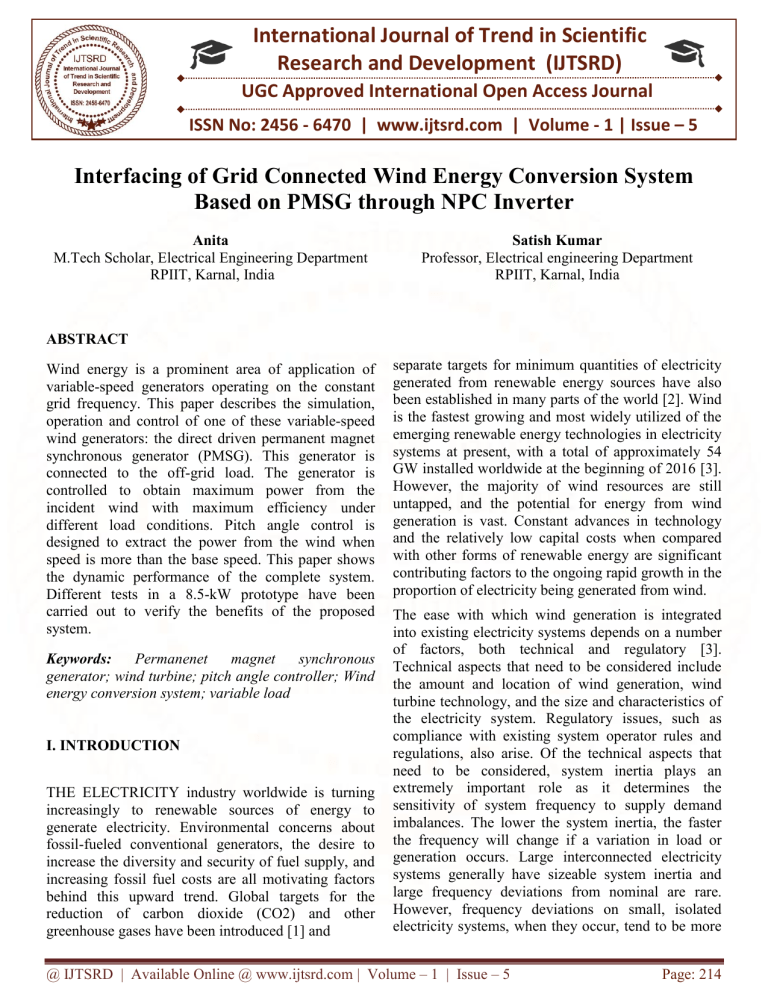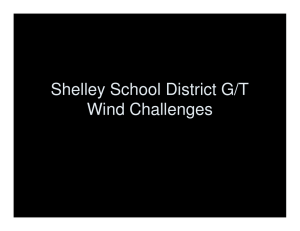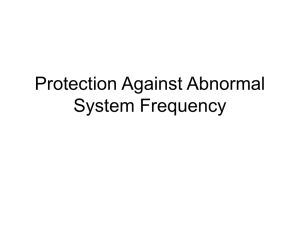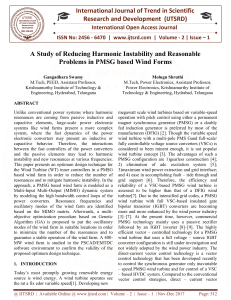
International Journal of Trend in Scientific
Research and Development (IJTSRD)
UGC Approved International Open Access Journal
ISSN No: 2456 - 6470 | www.ijtsrd.com | Volume - 1 | Issue – 5
Interfacing of Grid Connected Wind Energy Conversion System
Based on PMSG through NPC Inverter
Anita
M.Tech Scholar, Electrical Engineering Department
RPIIT, Karnal, India
Satish Kumar
Professor, Electrical engineering Department
RPIIT, Karnal, India
ABSTRACT
Wind energy is a prominent area of application of
variable-speed generators operating on the constant
grid frequency. This paper describes the simulation,
operation and control of one of these variable-speed
wind generators: the direct driven permanent magnet
synchronous generator (PMSG). This generator is
connected to the off-grid load. The generator is
controlled to obtain maximum power from the
incident wind with maximum efficiency under
different load conditions. Pitch angle control is
designed to extract the power from the wind when
speed is more than the base speed. This paper shows
the dynamic performance of the complete system.
Different tests in a 8.5-kW prototype have been
carried out to verify the benefits of the proposed
system.
Keywords:
Permanenet
magnet
synchronous
generator; wind turbine; pitch angle controller; Wind
energy conversion system; variable load
I. INTRODUCTION
THE ELECTRICITY industry worldwide is turning
increasingly to renewable sources of energy to
generate electricity. Environmental concerns about
fossil-fueled conventional generators, the desire to
increase the diversity and security of fuel supply, and
increasing fossil fuel costs are all motivating factors
behind this upward trend. Global targets for the
reduction of carbon dioxide (CO2) and other
greenhouse gases have been introduced [1] and
separate targets for minimum quantities of electricity
generated from renewable energy sources have also
been established in many parts of the world [2]. Wind
is the fastest growing and most widely utilized of the
emerging renewable energy technologies in electricity
systems at present, with a total of approximately 54
GW installed worldwide at the beginning of 2016 [3].
However, the majority of wind resources are still
untapped, and the potential for energy from wind
generation is vast. Constant advances in technology
and the relatively low capital costs when compared
with other forms of renewable energy are significant
contributing factors to the ongoing rapid growth in the
proportion of electricity being generated from wind.
The ease with which wind generation is integrated
into existing electricity systems depends on a number
of factors, both technical and regulatory [3].
Technical aspects that need to be considered include
the amount and location of wind generation, wind
turbine technology, and the size and characteristics of
the electricity system. Regulatory issues, such as
compliance with existing system operator rules and
regulations, also arise. Of the technical aspects that
need to be considered, system inertia plays an
extremely important role as it determines the
sensitivity of system frequency to supply demand
imbalances. The lower the system inertia, the faster
the frequency will change if a variation in load or
generation occurs. Large interconnected electricity
systems generally have sizeable system inertia and
large frequency deviations from nominal are rare.
However, frequency deviations on small, isolated
electricity systems, when they occur, tend to be more
@ IJTSRD | Available Online @ www.ijtsrd.com | Volume – 1 | Issue – 5
Page: 214
International Journal of Trend in Scientific Research and Development (IJTSRD) ISSN: 2456-6470
sizeable. When connecting wind turbines to small
isolated power systems, their contribution to system
inertia must be considered. The addition of
synchronous generation to a power system
intrinsically increases the system inertial response.
This intrinsic increase does not necessarily occur with
the addition of wind turbine generators due to their
differing electromechanical characteristics. Therefore,
the displacement of conventional synchronous
generation with wind generation may result in an
erosion of system inertial response resulting in
increased rates of change of frequency (ROCOF) and
larger frequency excursions. In small isolated
systems, these phenomena are particularly challenging
due to low system inertia. Where wind turbines are
found to severely impact on system inertial response,
system operators need to consider altering their
frequency control strategies to avoid large rates of
change of frequency and/or large frequency
excursions. Wind turbine generators (WTGs) can be
divided into two basic categories: fixed speed and
variable speed. A fixed-speed WTG generally uses a
squirrel-cage induction generator to convert the
mechanical energy from the wind turbine into
electrical energy. During a frequency excursion, the
relationship between the system frequency and the
electromagnetic torque of any induction machine will
determine the inertial response. As there is a strong
coupling between the squirrel-cage induction
generator stator and the power system, and due to the
low nominal slip of 1%–2% [7], any deviations in
system speed will result in a change in rotational
speed. This linking of rotor speed with system speed
gives rise to an inertial response from the fixed-speed
WTG when the system frequency falls.
from the fixed-speed WTG when the system
frequency falls.
Variable-speed WTGs can offer increased efficiency
in capturing the energy from wind over a wider range
of wind speeds, along with better power quality and
the ability to regulate the power factor, by either
consuming or producing reactive power. Doubly fed
induction generator (DFIG) and multi-pole
synchronous generator are popular types of variable
speed WTGs. Both forms of generator have power
electronic converters between the electrical machine
and the power system. The multi-pole synchronous
generator allows variable-speed operation by
employing a back-to-back ac/dc/ac converter attached
to the stator of the synchronous machine. As a result,
the stator is isolated from and, consequently,
unaffected by any changes in the frequency of the
power system. Therefore, the power output from the
WTG does not change and no inertial response is
obtained during a frequency event.
The power electronic converter in the DFIG, on the
other hand, is attached to the rotor. The rotor is
connected to the power system through this back-toback ac/dc/ac converter, while the stator is connected
directly to the power system. The net power output
from the DFIG is the sum of the power outputs from
both the stator and the rotor [8], [9]. During a system
frequency excursion, any inertial response provided
by the DFIG depends on the relationship between the
electromagnetic torque of the machine and system
frequency. This relationship, in turn, depends upon
the type of controllers used in the converter and the
parameters of the controllers [10].
III.
II.
Modeling of PMSG Based WECS
Wind Turbine Technology
Wind turbine generators (WTGs) can be divided into
two basic categories: fixed speed and variable speed.
A fixed-speed WTG generally uses a squirrel-cage
induction generator to convert the mechanical energy
from the wind turbine into electrical energy. During a
frequency excursion, the relationship between the
system frequency and the electromagnetic torque of
any induction machine will determine the inertial
response. As there is a strong coupling between the
squirrel-cage induction generator stator and the power
system, and due to the low nominal slip of 1%–2%
[7], any deviations in system speed will result in a
change in rotational speed. This linking of rotor speed
with system speed gives rise to an inertial response
A. Wind Turbine Modelling
The output power Pa, developed by wind turbine with
blade radius ‘r’ can be expressed as under:
1
𝑃𝑎 = 2 𝜌𝜋𝑟 2 Cp (λ, β)Vw3
(1)
where, 𝜋𝑟 2 is the rotor swept area, Cp is the power coefficient, λ is the tip speed ratio, β is the pitch angle
while Vw being the wind speed. The tip speed ratio λ
can be described as:
@ IJTSRD | Available Online @ www.ijtsrd.com | Volume – 1 | Issue – 5
𝑟𝛺
𝜆=𝑉
𝑤
(2)
Page: 215
International Journal of Trend in Scientific Research and Development (IJTSRD) ISSN: 2456-6470
Where, Ω is the turbine rotor speed. The relevant
wind turbine characteristics are depicted in Fig. 1.
C. PMSG Modelling
Due to many advantages of PMSG over induction
generator it is used in designed model of wind energy
conversion system. The dynamic model of the PMSG
is derived from the two phase synchronous reference
frame, which the q-axis is 90° ahead of the d-axis
with respect to the direction of rotation. The
mathematical model of the PMSG in the synchronous
reference frame (in the state equation form) is given
by:
did
Fig.1: Mechanical power versus turbine speed
characteristics.
dt
diq
dt
The wind turbine is designed for 8.5 kW and base
speed of 12 m/sec.
There are different parameters on which it depends
and they are given as following.
➢
➢
➢
➢
➢
Base power of the electrical generator is given as:
8.5e3/0.9 W
Mechanical output power of the model: 8.5e3 W
Base wind speed of system : 8 m/sec
Maximum power at base wind speed: 0.8 pu
Base rotational speed :1 pu.
B. Two Mass Driven Model
In this paper a two mass driven model for coupling is
used and it has the equation:
𝑇𝑠ℎ = 𝐾𝑠ℎ 𝜃𝑠ℎ + 𝐷𝑡
𝑑𝜃𝑡𝑤
𝐷𝑡
(3)
Where Tsh is shaft torque, Ksh is shaft stiffness, θtw is
shaft twist angle, Dt is damping coefficient, Ht is
inertia constant of the turbine, Hg is inertia constant of
the PMSG.
1
= L (−R s id + ωe Lq iq + ud )
d
1
= L [−R s iq − ωe (Ld id + φd ) + uq ]
q
(4)
(5)
The above equations are used to model the PMSG.
IV.
Control, Simulations and Results
The grid connected WECS through NPC inverter is
modelled and simulated in MATLAB/Simulink
environment. The proposed system is subjected
variable and constant wind speed. The effectiveness
of NPC inverter is verified at different load. The main
aim of this work is to maintain the voltage at point of
common coupling constant whatever may be the wind
speed and connected load. This is done by Neutral
Power Clamped (NPC) inverter. A PI based regulator
is used for generating the control pulses for the NPC
inverter. This will help in maintain the system voltage
constant at different perturbances. In this work the
wind speed is supposed to be varied between 7 m/sec
to 12 m/sec.
The simulation is done for the variable wind speed
and as expected the NPC inverter will come in to
action for maintaining the voltage constant.
Fig 2: Two mass driven model.
@ IJTSRD | Available Online @ www.ijtsrd.com | Volume – 1 | Issue – 5
Page: 216
International Journal of Trend in Scientific Research and Development (IJTSRD) ISSN: 2456-6470
Fig.3: Each Phase Voltage at PCC.
Fig 4: Different parameters of WECS.
@ IJTSRD | Available Online @ www.ijtsrd.com | Volume – 1 | Issue – 5
Page: 217
International Journal of Trend in Scientific Research and Development (IJTSRD) ISSN: 2456-6470
When the wind turbine speed reaches to the cut-in
speed, the PMSG start producing power at time 0.018
seconds. This can be seen in fig.3. The phase voltage
starts building up at that moment.
As the wind speed varies the output power of the wind
turbine also changes. The power quality is generally
related to the frequency and voltage stability. These
two parameters determine the power quality. In this
work the voltage and frequency variations are in the
prescribed limits. With the variations of the wind
speed the phase voltage is held constant with the help
of NPC inverter. When there is need for voltage boost
the reactive power is injected in to the system and
vice-versa.
Vdc is the DC link voltage which is to be maintained 1
pu, this is done by the inverter control. In the fig.4, it
can be seen that PI based voltage controller, able to
control the Vdc after the drop in speed and rise in
speed.
Conclusions
In this thesis work, the scheme of voltage control (i.e.
using pitch angle control and PI based voltage
controller) for PMSG based WECS have been
investigated. Firstly basic components of wind
energy conversion system has been discussed like
turbine, generation part used, coupling part used. It is
concluded that when there is a change in wind speed
voltage dip or rise occur, there is change in voltage
level. Further there is effect of variable load on the
profile of the output voltage of the wind turbine
driven PMSG when there is no control scheme is
employed in the system.
An NPC inverter is used, which is able to maintain the
system voltage constant when there is change in the
wind speed and variation in the load. The NPC gate
pulses are produced a PI based controller which helps
in maintaining the voltage as per the prescribed limits.
[3]
[4]
[5]
[6]
[7]
[8]
[9]
[10]
electricity market,” Official J. Eur. Communities,
L283, pp. 33–40, Oct. 2001.
The European Wind Energy Association (EWEA)
and the European Commission’s Directorate
General for Transport and Energy DG TREN).
(2016) Wind Energy—The Facts. [Online].
Available:
http://www.ewea.org/06projects_events/proj_WEf
acts.htm.
Commission for Energy Regulation (CER). (2016)
Wind Farm Transmission Grid Code Provisions.
[Online].
Available:
http://www.cer.ie/CERDocs/cer04237.pdf.
Commission for Energy Regulation (CER). (2015)
Wind Generation Distribution Code Provisions.
[Online].
Available:
http://www.cer.ie/CERDocs/cer04318.pdf.
ELTRA. (2015) Specifications for Connecting
Wind Farms to the Transmission Network.
[Online].
Available:
http://www.eltra.dk/composite- 837.htm.
[A. P. Mullane, “Advanced control of wind energy
conversion systems,”
Ph.D. dissertation, Nat. Univ. Ireland, Univ.
College Cork, Cork, Ireland, 2004.
J. B.
Ekanayake, L. Holdsworth, X. Wu, and N.
Jenkins, “Dynamic modeling of doubly fed
induction generator wind turbines,” IEEE Trans.
Power Syst., vol. 18, no. 2, pp. 803–809, May
2003.
P. Pourbeik, R. J. Koessler, D. L. Dickmander,
and W. Wong, “Integration of large wind farms
into utility grids (Part 2—Performance issues),” in
Proc. IEEE Power Eng. Soc. Gen. Meeting, vol. 3,
Toronto, ON, Canada, Jul. 2003, pp. 1525–1528.
A. Mullane and M. O’Malley, “The inertialresponse of induction-machine based windturbines,” IEEE Trans. Power Syst., vol. 20, no. 3,
pp. 1496–1503, Aug. 2005.
REFERENCES
[1]
[2]
The United Nations Framework Convention on
Climate Change. (1997) The Kyoto Protocol.
[Online].
Available:
http://unfccc.int/resource/docs/convkp/kpeng.pdf.
“Directive 2016/77/EC of the European
Parliament and the Council of 27 September 2016
on the promotion of electricity produced from
renewable energy sources in the internal
@ IJTSRD | Available Online @ www.ijtsrd.com | Volume – 1 | Issue – 5
Page: 218






